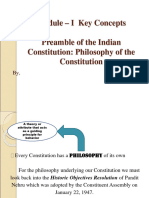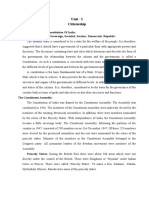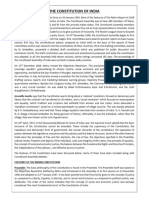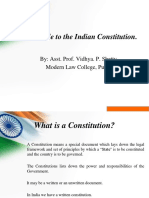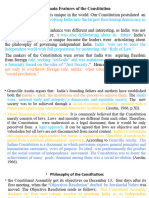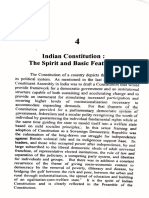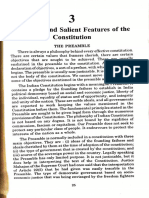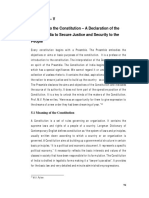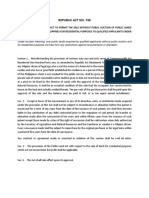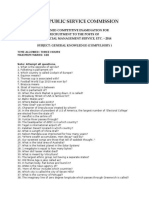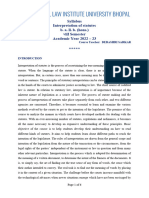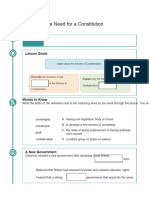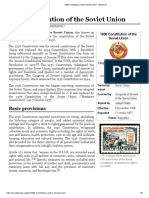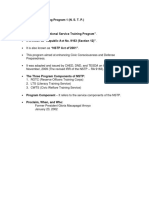0 ratings0% found this document useful (0 votes)
7 views7 pagesSelfstudys Com File
Chapter 9 discusses the evolution and principles of Indian democracy, emphasizing the importance of participatory democracy and the role of the Indian Constitution in ensuring social, economic, and political justice. It highlights the Karachi Resolution's vision for Swaraj and the establishment of Panchayati Raj Institutions to promote grassroots governance and empower marginalized communities. The chapter also addresses the challenges and responsibilities of local self-governance in India, particularly in relation to social welfare and financial management.
Uploaded by
pradeeshapradee0306Copyright
© © All Rights Reserved
We take content rights seriously. If you suspect this is your content, claim it here.
Available Formats
Download as PDF, TXT or read online on Scribd
0 ratings0% found this document useful (0 votes)
7 views7 pagesSelfstudys Com File
Chapter 9 discusses the evolution and principles of Indian democracy, emphasizing the importance of participatory democracy and the role of the Indian Constitution in ensuring social, economic, and political justice. It highlights the Karachi Resolution's vision for Swaraj and the establishment of Panchayati Raj Institutions to promote grassroots governance and empower marginalized communities. The chapter also addresses the challenges and responsibilities of local self-governance in India, particularly in relation to social welfare and financial management.
Uploaded by
pradeeshapradee0306Copyright
© © All Rights Reserved
We take content rights seriously. If you suspect this is your content, claim it here.
Available Formats
Download as PDF, TXT or read online on Scribd
You are on page 1/ 7
CHAPTER 9
Story of Indian Democracy
Chapter at Glance • The Karachi Resolution reflects a vision of
democracy that meant not just formal holding of
The idea of democracy in India
elections but a substantive reworking of the Indian
• Democracy is a government of the people, by the social structure in order to have a genuine
people, and for the people. democratic society.
• Democracies fall into two basic categories, direct • The Karachi Resolution clearly spells out the vision
and representative. of democracy that the nationalist movement in
• In a direct democracy, all citizens, without the India had.
intermediary of elected or appointed officials, can • It articulates the values that were further given full
participate in making public decisions. expression in the Indian Constitution.
• Ours is a representative democracy. Every citizen • The Preamble of the Indian Constitution seeks to
has the important right to v ote her/ his ensure not just political justice but also social and
representative. economic justice.
• People elect their representatives to all levels from • The equality is not just about equal political rights
Panchayats, Municipal Boards, State Assemblies but also of status and opportunity.
and Parliament.
Karachi Resolution, 1931
• There has increasingly been a feeling that
What Swaraj will Include?
democracy ought to involve people more regularly
and should not just mean casting a vote every five Karachi Congress Resolution, 1931 Swaraj as conceived
years. by the Congress should include real economic freedom
of the masses. The Congress declares that no constitution
• Both the concepts of participatory democracy and
will be acceptable to it unless it provides or enables the
decentralised governance have thus become
Swaraj Government to provide for:
popular.
1. Freedom of expression, association and meeting.
• Participatory democracy is a system of democracy
in which the members of a group or community 2. Freedom of religion.
participate collectively in the taking of major 3. Protection of all cultures and languages.
decisions. This chapter will discuss the panchayati 4. All citizens shall be equal before the law.
raj system.
5. No disability in employment or trade or profession
Indian Constitution on account of religion, caste or sex.
The Core Values Of Indian Democracy 6. Equal rights and duties for all in regard to public
• India fought for its independence from British wells, schools, etc.
colonialism a vision of what Indian democracy ought 7. All to have right to bear arms in accordance with
to look like emerged. regulations.
• As far back as in 1928, Motilal Nehru and eight 8. No person to be deprived of property or liberty
other Congress leaders drafted a constitution for except in accordance with law.
India. 9. Religious neutrality of State.
• In 1931, the resolution at the Karachi session of 10. Adult Suffrage.
the Indian National Congress dwelt on how
11. Free compulsory primary education.
independent India's constitution should look like.
12. No titles to be conferred.
13. Capital punishment to be abolished. Nation}' IN OUR
14. Freedom of movement for every citizen of India and CONSTITUENTASSEMBLY
right to settle and acquire property in any part thi s twenty-sixth day of
thereof, and equal protection of law. Nov ember, 1949, do
HEREBYADOPT, ENACT
15. Proper standard of life for industrial workers and
AND GIVE TO OURSELVES
suitable machinery for settlement of disputes
THIS CONSTITUTION.
between employers and workers and protection
against old age, sickness, etc.
16. All labour to be free from conditions of serfdom. Debates in Constituent Assembly
17. Special protection of women workers. • In 1939, Gandhiji wrote an article in the 'Harijan'
18. Children not to be employed in mines and factories. called 'The Only Way' in which he said "… the
Constituent Assembly alone can produce a
19. Rights of peasants and workers to form unions.
constitution indigenous to the country and truly
20. Reform of system of land revenue and tenure and and fully representing the will of the people" one
rent, exempting rent and revenue for uneconomical based on "unadulterated adult franchise for both
holdings and reduction of dues payable for smaller men and women".
holdings.
• The popular demand in 1939 for a Constituent
21. Inheritance tax on graduated scale. Assembly was, after several ups and downs
22. Reduction of military expenditure by at least half. conceded by Imperialist Britain in 1945.
23. No servant of State ordinarily to be paid above Rs • In July 1946, the elections were held. In August
500 per month. 1946, The Indian National Congress' Expert
24. Abolition of Salt tax. Committee moved a resolution in the Constituent
Assembly.
25. Protection of indigenous cloth against competition
of foreign cloth. • This contained the declaration that India shall be a
Republic where the declared social, economic and
26. Total prohibition of intoxicating drinks and drugs.
political justice will be guaranteed to all the people
27. Currency and exchange in national interest. of India.
28. Nationalisation of key industries and services, • On matters of social justice, there were lively
railways, etc. debates on whether government functions should
29. Relief of agricultural indebtedness and control of be prescribed and the state should be bound down
usury. to them.
30. Military training for citizens. • Issues debated ranged from right to employment,
PREAMBLE to social security, land reforms to property rights,
to the organisation of panchayats.
WE, THE PEOPLE OF INDIA,
having solemnly resolved to The Constitution and Social Change
constit ute I ndia int o a • The basic objectives laid down in the Constitution
[ SOVEREIGN SOCIALIST and which are generally agreed in the Indian political
SECULAR DEMOCRATIC world as being obviously just.
REPUBLIC] and to secure to • These would be empowerment of the poor and
all its citizen: marginalised, poverty alleviation, ending of caste
JUSTICE, social, economic and positive steps to treat all groups equally.
and political; • Competing interests do not always reflect a clear
LIBERTY of t hought, class divide.
expression, belief, faith and Note: Take the issue of the close down of a factory because
worship; it emits toxic waste and affects the health of those around.
EQUALITY of status and This is a matter of life, which the Constitution protects.
opportunity; The flipside is that the closure will render people jobless.
And to promote among them Livelihood again, is a matter of life that the Constitution
all protects. It is interesting that at the time of drawing up
FRATERNITY assuring the the Constitution, the Constituent Assembly was fully
dignity of the individual and the aware of this complexity and plurality but was intent on
{unity and integrity of the securing social justice as a guarantee.
Constitutional Norms And Social Justice: principles in keeping with the contemporary
Interpretation To Aid Social Justice understanding on social justice.
• Law is law because it carries the means to coerce • The Directive Principle on village panchayats was
or force obedience. The power of the state is behind moved as an amendment in the Constituent
it. Assembly by K. Santhanam. After forty odd years
it became a Constitutional imperative after the 73rd
• The basic norm from which all other rules and Amendment in 1992.
authorities flow is called the Constitution. It is the
document that constitutes a nation's tenets. The Panchayati Raj And The Challenges Of
• The Indian Constitution is India's basic norm. All Rural Social Transformation
other laws are made as per the procedures the • Panchayati Raj translates literally to 'Governance
Constitution prescribes. by five individuals'.
• These laws are made and implemented by the • The idea is to ensure at the village or grass root
authorities specified by the Constitution. level a functioning and vibrant democracy.
• A hierarchy of courts (which too are authorities • W hen the constitution was being draf ted
created by the Constitution) interpret the laws when panchayats did not find a mention in it. At this
there is a dispute. juncture, a number of members expressed their
• The Supreme Court is the highest court and the sorrow, anger and disappointment over this issue.
ultimate interpreter of the Constitution. • The concept of local government was dear to
• The Supreme Court has enhanced the substance Gandhiji too. He envisaged each village as a self-
of Fundamental Rights in the Constitution in many sufficient unit conducting its own affairs and saw
important ways. gram-swarajya to be an ideal model to be continued
after independence.
- A Fundamental Right includes all that is
incidental to it. The three-tier system of Panchayati
Raj Institution
- The terse words of Article 21 recognising the
right to life and liberty have been interpreted as • The structure is like a
including all that goes into a life of quality, pyramid.
including livelihood, health, shelter, education - At the base of
and dignity. In various pronouncements different the structure
attributes of 'life' have been expanded and 'life' stands the unit of
has been explained to mean more than mere dem ocracy or
animal existence. These interpretations have Gram Sabha.
been used to provide relief to prisoners - This consists of
subjected to torture and deprivation, release the entire body of
and rehabilitation of bonded labourers, against cit izens in a
environmentally degrading activities, to provide village or grama.
primary health care and primary education.
- It is this general
- In 1993 the Supreme Court held that Right to body that elects
Information is part of and incidental to the Right the local
to Expression under Article 19(1) (a). government and
- Reading Directive Principles into the content charges it with
of Fundamental Rights. The Supreme Court s p e c i f i c
read the Directive Principle of "equal pay for responsibilities.
equal work" into the Fundamental Right to - The Gram
Equality under Article 14 and has provided relief Sabhas ideally
to many plantation and agricultural labourers ought to provide
and to others. an open forum for
• The Constitution is not just a ready referencer of discussions and
do's and don'ts for social justice. It has the potential v il lage-lev el
for the meaning of social justice to be extended. development
• Social movements have also aided the Courts and act iv it ies and
authorities to interpret the contents of rights and play a crucial role
in ensuring
inclusion of the • A constitutional amendment prescribed a three-
weaker sections tier system of local self-governance for the entire
in the decision- country, effective since 1992-93.
m a k i n g Powers And Responsibilities Of Panchayats
processes.
• According to the Constitution, Panchayats should
• The 73rd Amendment be given powers and authority to function as
provided a three-tier institutions of self-government.
system of Panchayati
Raj for all states having • It, thus, requires all state governments to revitalise
a population of over local representative institutions.
twenty lakhs • The following powers and responsibility were
• It became mandatory delegated to the Panchayats:
that election to these - to prepare plans and schemes for economic
bodies be conducted development
every five years. - to promote schemes that will enhance social
• It provided reservation of justice
seats for the Scheduled - to levy, collect and appropriate taxes, duties,
Castes, Scheduled tolls and fees
Tribes and thirty three - help in the devolution of governmental
percent seats f or responsibilities, especially that of finances to
women. local authorities
• It constituted District
Social Welfare
Planning Committee to
prepare draf ts and • Social welfare responsibilities of the Panchayats
develop plans for the include the maintenance of burning and burial
district as a whole grounds, recording statistics of births and deaths,
establishment of child welfare and maternity
centres, control of cattle pounds, propagation of
Establishing PRIs family planning and promotion of agricultural
• In 1992 that grassroot democracy or decentralised activities.
gov ernance was ushered in by t he 73rd • The development activities include the construction
Constitutional Amendment. of roads, public buildings, wells, tanks and schools.
• This act provided constitutional status to the • They also promote small cottage industries and
Panchayati Raj Institutions (PRIs). take care of minor irrigation works.
• It is compulsory now for local self-government • Many government schemes like the Integrated Rural
bodies in rural and municipal areas to be elected Development Programme (IRDP) and Integrated
every five years. Child Development Scheme (ICDS) are monitored
• The control of local resources is given to the elected by members of the panchayat.
local bodies. Finances
• The 73rd and 74th amendments to the Constitution • The main income of the Panchayats is from tax
ensured the reservation of one third of the total levied on property, profession, animals, vehicles,
seats for women in all elected offices of local bodies cess on land revenue and rentals.
in both the rural and urban areas.
• The resources are further increased by the grants
• Out of this, 17 per cent seats are reserved for received through the Zilla Panchayat.
women belonging to the scheduled castes and
• It is also considered compulsory for Panchayat
tribes.
offices to put up boards outside their offices, listing
• This amendment is significant as for the first time the break up of funds received, and utilisation of
it brought women into elected bodies which also the financial aid received.
bestowed on them decision making powers.
• This exercise was taken up to ensure that people
• One third of the seats in local bodies, gram at the grassroot level should have the 'right to
panchayats, village panchayats, municipalities, information' - opening all functioning to the public
city corporations and district boards are reserved eye.
for women.
• People had the right to scrutinise allocation of • Political Party is an organisation established with
money and ask reasons for decisions that were the aim of achieving governmental power and using
taken for the welfare and development activities of that power to pursue a specific programme.
the village. • Political parties are based on certain understanding
Justice of society and how it ought to be.
• Nyaya Panchayats have been constituted in some • In a democratic system the interests of different
states. They possess the authority to hear some groups are also represented by political parties,
petty, civil and criminal cases. who take up their case.
• They can impose fines but cannot award a • Different interest groups will work towards
sentence. influencing political parties.
• These village courts have often been successful in • Interest Groups are organised to pursue specific
bringing about an agreement amongst contending interests in the political arena, operating primarily
parties. by lobbying the members of legislative bodies.
• They have been particularly effective in punishing • In some situations, there may be political
men who harass women for dowry and perpetrate organisations which seek to achieve power but are
violence against them. denied the opportunity to do so through standard
means.
Panchayati Raj In Tribal Area
• These organisations are best regarded as
• Many tribal areas have had a rich tradition of movements until they achieve recognition.
grassroot democratic functioning.
• Some argue that the concept of pressure groups
• All the three major ethnic tribal groups, namely, underestimate the power that dominant social
the Khasis, Jaintias and the Garos have their own groups such as class, caste or gender have in
traditional political institutions that have existed society.
for hundreds of years.
• They feel that it would be more accurate to suggest
• These political institutions were fairly well-developed that dominant class or classes control the state.
and functioned at various tiers, such as the village
level, clan level and state level. • This does not negate the f act that social
movements and pressure groups also continue to
• For instance, in the traditional political system of play a very important role in a democracy.
the Khasis each clan had its own council known
as the 'Durbar Kur' which was presided over by the Some Important Groups
clan headman. • Industrialists form associations such as Federation
• Though there is a long tradition of grassroot of Indian Chambers and Commerce (FICCI) and
political institutions in Meghalaya, a large chunk Associat ion of Chambers of Commerce
of tribal areas lie outside the provisions of the 73rd (ASSOCHAM).
Amendment. • Workers form trade unions such as the Indian Trade
• This may be because the concerned policy makers Union Congress (INTUC) or the Centre for Indian
did not wish to interfere with the traditional tribal Trade Unions (CITU).
institutions. • Farmers form agricultural unions such as Shetkari
Political Parties, Pressure Groups And Sangathan. Agricultural labourers have their own
unions.
Democratic Politics
• In a democratic form of government political parties
are key actors.
• A political party may be defined as an organisation
oriented towards achieving legitimate control of
government through an electoral process.
Exercise
1. A community organization or a tribal council is an (c) Secured rights to dalits
example of which of the following type of (d) Ramrajya
Democracy? 7. As per Gandhiji, Constituent Assembly could
(a) Direct democracy produce Const ituti on on the basis of
(b) Indirect democracy …………………………
(c) Republican government (a) Unadulterated adult franchise for both men and
(d) None of the above women
2. British introduced western education to create a (b) Social inclusion
western educated Indian middle class. The reason (c) Economic equality
was - (d) Political rights
(a) To prove their superiority in India 8. The resolution declared that India shall be a Republic
(b) To help the colonial rulers to continue their rule where the declared social, economic and political
(c) To spread Christianity by conversion justice will be guaranteed to all the people of India
(d) To introduce nationalism in India was moved by -
3. 'Equality will be of no value without fraternity or (a) Independence Act, 1947
liberty. It seems that the three can coexist only if (b) Indian National Congress
one follows the way of the Buddha.' This statement (c) Gaya session of Congress
was given by - (d) Karachi resolution
(a) Mahatma Gandhi 9. The right to useful employment could and should
(b) Raja Rammohun Roy be made real by a categoric obligation on the part
(c) B R Ambedkar of the state to provide useful work to every citizen
(d) Subhash Chandra Bose who was able and qualified. It was suggested by -
4. Choose the incorrect statement: (a) Mahatma Gandhi (b) Jawaharlal Nehru
(a) Motilal Nehru and eight other Congress leaders (c) K T Shah (d) B R Ambedkar
drafted a constitution for India in 1928. 10. Which of the following are true about Directive
(b) In 1931, the Karachi resolution of the Indian Principals of States Policy?
National Congress dwelt on how independent I. It was adopted by the Constituent Assembly
India's constitution should look like. II. It is enforceable in the court
(c) Nehru Report reflected a vision of democracy III. Constituent Assembly added the clause of
after independence. organizing village panchayats
(d) Karachi resolution articulates the values that (a) I only (b) II and III
were further given full expression in the Indian (c) I and II (d) All of the above
Constitution. 11. Which of the following are principals under Directive
5. Equality in India is about - Principal of States policy?
I. Political rights I. Promotion of cottage industry on cooperative
II. Status lines in urban and rural areas
III. Opportunities II. Agriculture and animal husbandry to be
(a) I and II (b) II and III organized on modern lines
(c) III only (d) All of the above III. Village panchayat should be organized and
6. Congress declares that no constitution will be endow with the powers and authority to be
acceptable unless it provides or enables the Swaraj effective units of local self-government.
Government. As per Congress, Swaraj includes: (a) I and II (b) II and III
(a) Suffrage (c) I only (d) All of the above
(b) Real economic freedom
12. The issue of the close down of a factory because Read the following passage and answer question
it emits toxic waste and affects the health of those nos 18, 19 and 20:
around. What will be the impact of such action? Many tribal areas have had a rich tradition of grassroot
(a) Right to life will be protected democratic functioning. We give an illustrative example
(b) Closure will render people jobless from Meghalaya. All the three major ethnic tribal groups,
(c) Environment will be protected namely, the Khasis, Jaintias and the Garos have their
(d) All of the above own traditional political institutions that have existed for
13. Article 21 recognises the right to life and liberty. It hundreds of years. These political institutions were fairly
interprets - well-developed and functioned at various tiers, such as
I. Livelihood II. Dignity the village level, clan level and state level. For instance,
III. Shelter IV. Education in the traditional political system of the Khasis each clan
(a) I and IV (b) II, III and IV had its own council known as the 'Durbar Kur' which was
(c) I, II and III (d) All of the above presided over by the clan headman. Though there is a
long tradition of grassroot political institutions in
14. Right to information is part and incidental to the
Meghalaya, a large chunk of tribal areas lie outside the
following:
provisions of the 73rd Amendment. This may be because
(a) Fundamental Right
the concerned policy makers did not wish to interfere
(b) Directive Principal of States Policy
with the traditional tribal institutions.
(c) Fundamental Duties
18. Choose the incorrect statement about grassroot
(d) Preamble
democracy in tribal areas:
15. The concept of local self-government was dear to
(a) Tribal areas have a rich traditional grassroot
Mahatma Gandhi as it provides -
democracy.
(a) Decentralization
(b) Their traditional political institution is much
(b) Self-sufficiency in conducting its own affairs
older.
(c) Fight against will of upper caste
(c) Political institution is multi-tiered and
(d) Freedom from exploitation of down trodden
independent of each other.
16. Which of the provisions are incorporated in 73rd
(d) None of the above
and 74th Amendment Act?
19. Darbar Kur in Khaisis traditional political system
I. 1/3rd seats to be reserved for women
functions as -
II. Schemes to be promoted and formulated to
enhance social justice (a) The upper tier of traditional political system
III. Collection of taxes and duties (b) Every tier has darbar kur
IV. Devolution of governmental responsibilities (c) It is functioning as per 73rd Amendment Act.
(a) I, II and III (b) II, III and IV (d) A council presided by clan headman.
(c) I, III and IV (d) All of the above 20. In Meghalaya despite of its long traditional political
17. Which of the following is true regarding Nyaya institution, a large chunk of tribal areas lie outside
Panchayats? the provisions of the 73rd Amendment. The reason
I. It is constituted in every state to provide justice is -
to everyone. (a) Policy makers do not wish to interfere in the
II. It possesses the authority to hear some petty, traditional institutions.
civil and criminal cases. (b) Every tribe is having its own tradition and rules.
III. It can impose fines and award a sentence. (c) Rise in insurgency against government.
(a) I and II (b) II only (d) None of the above
(c) II and III (d) All of the above
Answer Keys
1. (a) 2. (b) 3. (c) 4. (c) 5. (d) 6. (b) 7. (a) 8. (b) 9. (c) 10. (a)
11. (b) 12. (b) 13. (d) 14. (a) 15. (b) 16. (c) 17. (b) 18. (c) 19. (d) 20. (a)
You might also like
- Module 4 Unit 2 Preamble of Indian ConstitutionNo ratings yetModule 4 Unit 2 Preamble of Indian Constitution10 pages
- PREAMBLE WORKSHEET (E) .PDF - 674fe766af09dNo ratings yetPREAMBLE WORKSHEET (E) .PDF - 674fe766af09d7 pages
- Preamble To The Indian Constitution PDFNo ratings yetPreamble To The Indian Constitution PDF26 pages
- The Main Features of The Indian Constitution and Debates in The Constituent AssemblyNo ratings yetThe Main Features of The Indian Constitution and Debates in The Constituent Assembly12 pages
- 70ST MAINS NOTES Week-1 (Polity) (English)No ratings yet70ST MAINS NOTES Week-1 (Polity) (English)29 pages
- IC - Unit 1 - The Indian Constitution FundamentNo ratings yetIC - Unit 1 - The Indian Constitution Fundament18 pages
- Preamble THE Constitution of India: Sarita - Assistant Professor of Law100% (1)Preamble THE Constitution of India: Sarita - Assistant Professor of Law38 pages
- Indian Constitution Module 1 Philosophy and FramingNo ratings yetIndian Constitution Module 1 Philosophy and Framing12 pages
- UNIT 1 Introduction To Indian ConstitutionNo ratings yetUNIT 1 Introduction To Indian Constitution36 pages
- Unit 5 Constitutional Foundations : 5.0 ObjectivesNo ratings yetUnit 5 Constitutional Foundations : 5.0 Objectives13 pages
- Constitutional-Law-I-Sem-Ii-2022-23-1 - 43527772408No ratings yetConstitutional-Law-I-Sem-Ii-2022-23-1 - 43527772408159 pages
- 29 Oct (Preamble of The Constitution) - ShafiqNo ratings yet29 Oct (Preamble of The Constitution) - Shafiq3 pages
- Salient Features of The Indian ConstitutionNo ratings yetSalient Features of The Indian Constitution13 pages
- Indian Polity Notes .PDF 20250114 011433 0000No ratings yetIndian Polity Notes .PDF 20250114 011433 000011 pages
- Final Report of The Louisiana Purchase Exposition Commission (1906)No ratings yetFinal Report of The Louisiana Purchase Exposition Commission (1906)406 pages
- In Re Petition For Issuance of Writ of Habeas Corpus of Camilo L. Sabio G.R. No. 174340 October 17 2006No ratings yetIn Re Petition For Issuance of Writ of Habeas Corpus of Camilo L. Sabio G.R. No. 174340 October 17 20061 page
- Distribution of Legislative Power BW Union and StateNo ratings yetDistribution of Legislative Power BW Union and State9 pages
- The Hindu Vocabulary Words Questions PDF Download 30th June 2021No ratings yetThe Hindu Vocabulary Words Questions PDF Download 30th June 202110 pages
- Transitional Constitution Amend. 4 2017No ratings yetTransitional Constitution Amend. 4 201736 pages
- (Template) 3315-01-07 NeedforaConstitution GN SENo ratings yet(Template) 3315-01-07 NeedforaConstitution GN SE8 pages
- 2024 Key of American Revolution and Constitution Test ReviewNo ratings yet2024 Key of American Revolution and Constitution Test Review2 pages
- Bangladesh Italian Marble Works Ltd. v. Government of Bangladesh - WikipediaNo ratings yetBangladesh Italian Marble Works Ltd. v. Government of Bangladesh - Wikipedia2 pages


